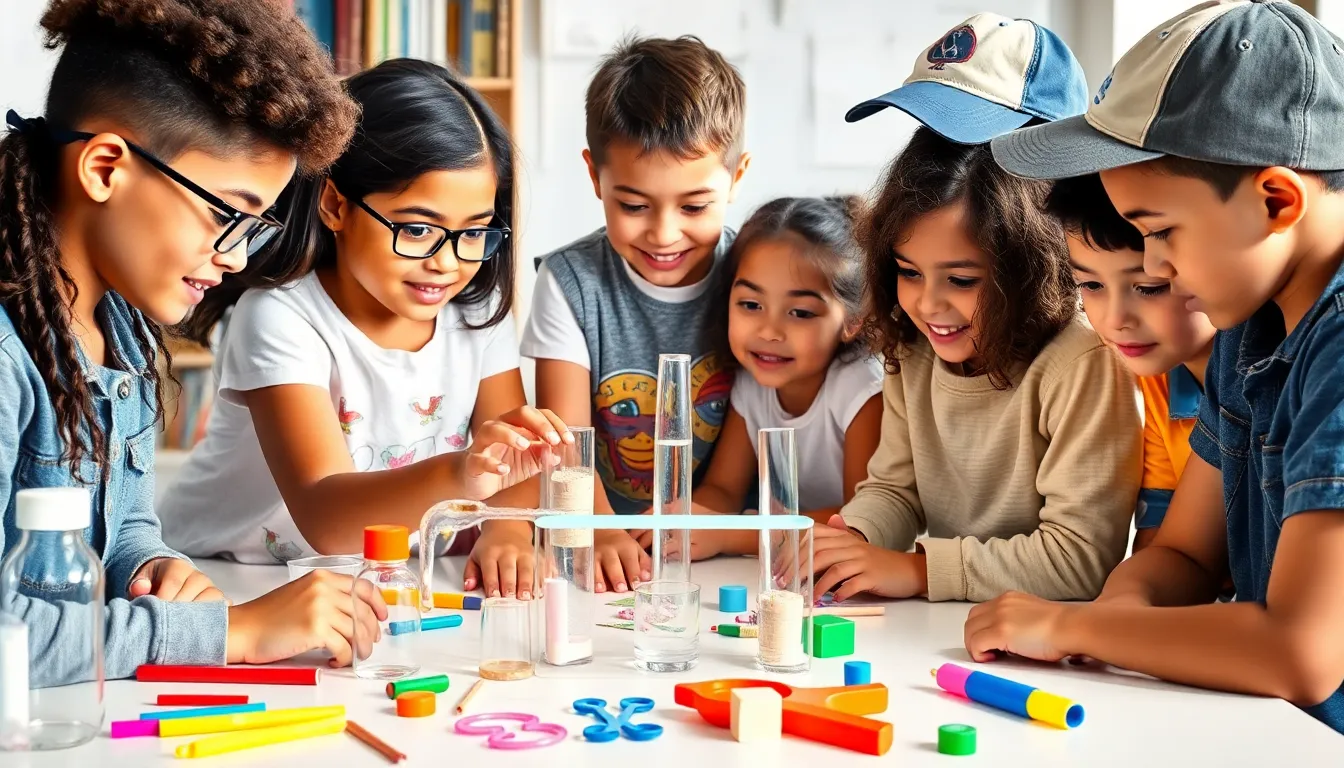Table of Contents
ToggleSTEM for kids isn’t just a buzzword; it’s the secret sauce for sparking curiosity and creativity in young minds. Picture this: kids donning lab coats, conducting experiments that could rival a mad scientist’s best work, all while having a blast. Science, technology, engineering, and math aren’t just subjects in school; they’re the building blocks of innovation and problem-solving that can lead to the next big thing—like a robot that fetches snacks!
In a world where coding is as essential as learning to ride a bike, introducing kids to STEM opens up a universe of possibilities. It’s about more than equations and formulas; it’s about teaching them to think critically and embrace challenges. So buckle up, because diving into the world of STEM for kids is like embarking on an adventure where imagination meets reality, and who knows what they might invent next?
What Is STEM for Kids?
STEM for kids refers to educational approaches focusing on science, technology, engineering, and math. Engaging children in these subjects through interactive experiences builds essential skills. Activities can include hands-on experiments, coding games, or engineering challenges.
Exposure to STEM encourages curiosity and creativity. Children learn to explore concepts like physics through simple experiments or engage in engineering by building structures with various materials. These experiences foster critical thinking and collaborative problem-solving skills.
STEM education also prepares kids for future careers. With technology constantly evolving, understanding coding and data analysis becomes increasingly important. Job markets demand proficiency in STEM fields, emphasizing the need for early education in these areas.
Programs and resources available for young learners enhance STEM understanding. Schools, community centers, and online platforms offer workshops and projects for different age groups. Parents can support their children’s learning by providing access to educational tools and encouraging participation in STEM-focused activities.
Diverse opportunities in STEM exist beyond traditional academics. Exploring robotics, environmental science, or mathematics helps children find passion and excitement in learning. STEM isn’t just about facts; it’s about nurturing a mindset that embraces innovation and exploration.
The Importance of STEM Education


STEM education plays a vital role in preparing children for a future characterized by rapid technological advancements. It encourages exploration and creativity, equipping young learners with essential skills.
Fostering Critical Thinking
Critical thinking develops through engaging activities that challenge children to analyze, evaluate, and create. These processes allow kids to take ownership of their learning. They learn to question assumptions and consider multiple perspectives. STEM projects encourage students to make predictions, test their hypotheses, and draw conclusions based on data collected. This hands-on approach strengthens their reasoning abilities. With each experiment or challenge, kids cultivate a mindset that values inquiry and reflection. They learn that asking the right questions is just as important as finding the answers.
Encouraging Problem-Solving Skills
Problem-solving skills thrive in STEM environments due to real-world applications. Engaging in projects, kids encounter scenarios that require logical thinking and resourcefulness. They navigate through obstacles to arrive at effective solutions. Children gain confidence as they tackle complex tasks, leading to a sense of accomplishment. STEM activities often promote teamwork, allowing kids to collaborate with peers on solutions. By working together, they learn to communicate ideas, negotiate, and share responsibilities. Such experiences prepare children to confront challenges they will face in academics and future careers.
STEM Subjects Explained
STEM encompasses four key subjects: science, technology, engineering, and mathematics. Each area offers unique opportunities for exploration and skill development.
Science
Science captivates curiosity through experimentation and exploration. Students engage with scientific concepts by conducting hands-on experiments, observing phenomena, and asking questions. They learn to formulate hypotheses and analyze data, which fosters critical thinking. Exposure to biology, chemistry, and physics sparks interest and encourages a deeper understanding of the world. Children gain practical knowledge that applies to everyday life, enhancing their analytical skills.
Technology
Technology plays a significant role in shaping modern education. Introductions to coding and digital tools cultivate skills that are essential for future careers. Learning platforms and educational games provide interactive experiences that make technology engaging. Collaborative projects often use software applications to solve real-world problems. By navigating these tools, kids develop technological literacy, preparing them for a world increasingly driven by innovation.
Engineering
Engineering encourages creativity through design and problem-solving. Kids engage in building projects that challenge them to think critically and practically. They learn to apply scientific principles by creating structures or designing solutions to specific problems. Collaborative engineering activities emphasize teamwork, requiring communication and brainstorming. This hands-on approach instills a sense of accomplishment and motivates continued exploration in the field.
Mathematics
Mathematics provides the foundation for logical reasoning and problem-solving. Students encounter math concepts in real-life scenarios, enhancing their understanding and retention. Engaging activities, such as math games and puzzles, stimulate interest and build confidence. Children develop essential skills in computation, measurement, and data analysis. Practical applications of math facilitate connections to other STEM subjects, highlighting its importance in everyday life and various career paths.
Engaging Kids in STEM Activities
Engaging kids in STEM activities fosters creativity and critical thinking. Hands-on experiences allow children to explore concepts in an interactive way.
Hands-On Experiments
Hands-on experiments captivate attention and spark curiosity. Kids can conduct simple science projects at home like growing crystals or creating volcanoes. These activities promote observation and hypothesis testing. Experimentation encourages children to think critically, analyze results, and draw conclusions. Successful hands-on projects also build confidence in their abilities. Group projects enhance collaboration, enabling children to share ideas and support each other. Kids learn practical skills that they’ll apply in real-world situations.
Interactive Learning Tools
Interactive learning tools are essential for engaging young minds in STEM. Coding games and apps introduce programming fundamentals in a fun way. Virtual simulations allow kids to explore scientific concepts without the need for extensive equipment. Educational platforms like online robotics classes provide opportunities for building and programming robots. Interactive quiz games promote mathematical skills while keeping learning enjoyable. These tools stimulate interest and encourage children to experiment more frequently. Easy accessibility of online resources empowers families to support learning outside the classroom. Engaging with these tools helps develop a lifelong passion for STEM subjects.




